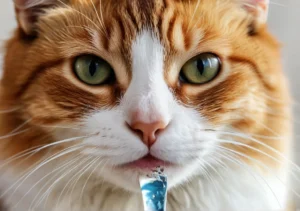Cats can be beloved pets for many, but when it comes to babies, they can pose certain risks that every parent should be aware of. So, why are cats bad for babies?
Cats and Babies: A Potential Risk
Cat Allergies: Understanding the Risks
Did you know that babies have a higher likelihood of developing allergies to cats compared to adults? Yup, those cute little furballs can actually trigger allergic reactions in your precious bundle of joy. Cat dander, saliva, and urine are the main culprits behind these allergies, causing symptoms like sneezing, coughing, rashes, and even asthma in some cases. It’s crucial to be aware of these risks, especially if you have a cat at home.
To minimize the chances of your baby developing allergies to cats, make sure to keep your furry friend out of the baby’s room and off of furniture where the baby plays. Regularly vacuum and clean your home to reduce the buildup of allergens. If possible, designate certain areas of your home as cat-free zones to create a safe space for your little one.
Pro Tip: Consider investing in an air purifier with a HEPA filter to help remove allergens from the air and create a healthier environment for your baby.
Cat Scratches: Protecting Your Baby
You might think those playful little scratches from your cat are harmless, but for infants, they can actually pose a risk of infection. Cat scratches can introduce bacteria into your baby’s skin, leading to complications like redness, swelling, and even fever. It’s essential to take precautions to protect your baby from these potential dangers.
To prevent cat scratches, never leave your baby unsupervised with a cat, especially when they are at the crawling stage and more likely to grab at the cat. Trim your cat’s nails regularly to minimize the risk of scratches, and teach your baby gentle handling techniques when interacting with the cat. If a scratch does occur, clean the wound promptly with soap and water, and keep an eye out for any signs of infection.
Remember, with a few simple steps, you can create a safe and harmonious environment for both your baby and your beloved feline friend. So, be proactive in safeguarding your little one from potential cat-related hazards. Your baby’s health and well-being are always the top priority!
Cat Litter: A Health Hazard
When it comes to babies and cats, one major concern is the cat litter box. Did you know that cat feces can contain a parasite called Toxoplasma gondii? This parasite can be harmful to babies if they come into contact with it. To reduce the risk, make sure to clean the litter box regularly and wash your hands thoroughly after handling it. Consider having someone else in the household take over this task while you’re caring for your little one.
Additional Unique Insight:
Invest in a high-quality litter that clumps well to minimize the spread of potentially harmful particles. This can help create a safer environment for your baby.
Cat Behavior: Supervision and Safety
Curious how cats and babies can get along? While cats can be great companions, their behavior can sometimes pose a risk to infants. It’s essential to closely supervise any interactions between your cat and baby to prevent accidents. Cats may not always understand how fragile babies are, so it’s crucial to create a safe environment for both.
- Create Safe Spaces: Provide your cat with a separate area where they can retreat when they need space. This can help prevent any unwanted interactions with your baby.
- Teach Boundaries: Encourage positive interactions between your cat and baby while setting clear boundaries. This can help establish a respectful relationship between the two.
Remember, with proper supervision and precautions, cats and babies can coexist harmoniously in your home.
Introducing Cats to Babies: Tips and Advice
Alright, let’s talk about how to make sure your new baby and your furry feline friend can coexist peacefully. When introducing your cat to your baby, start slow and steady. Allow your cat to sniff and investigate the baby from a safe distance. Always supervise their interactions and never leave them alone together.
Another tip is to create positive associations. Reward your cat with treats and affection when they are near the baby to reinforce good behavior. Make sure your cat has plenty of hiding spots and high spaces to retreat to if they feel overwhelmed.
Lastly, maintain your cat’s routine as much as possible. Cats love routine, and any drastic changes can stress them out. By keeping things consistent for your cat, you can help them adjust to the new addition to the family more smoothly. Remember, patience is key when introducing your cat to your baby!
Cat-Proofing Your Home: Creating a Safe Space
Alright, let’s make sure your home is a safe haven for both your baby and your cat. First things first, secure all electrical cords and outlets. Curious cats might find them tempting to chew on, posing a risk to your little one. Put baby gates in place to restrict your cat’s access to certain areas of the house where the baby will be spending most of their time.
Next, make sure all toxic substances like cleaning supplies and houseplants are out of reach. Cats can be sneaky little creatures and might explore places you never thought they would. Keep these items locked away to prevent any accidents.
Additionally, provide your cat with their own space, like a cozy bed or a designated room where they can escape to when they need some alone time. This will help them feel secure and reduce the chances of any unwanted interactions with the baby.
Remember, a little extra effort in cat-proofing your home can go a long way in creating a safe environment for both your baby and your beloved feline companion!
Alternatives to Cats: Exploring Other Pet Options
If you’re concerned about the potential risks cats pose to your baby, fear not! There are plenty of alternative pet options that can still bring joy and companionship to your family. Consider low-maintenance pets like fish, turtles, or small rodents. These adorable critters can be a great alternative to cats, reducing any potential allergens or dangers for your little one.
If you’re looking for a furry friend, consider a hypoallergenic dog breed like a poodle or bichon frise. These breeds shed less dander, making them a safer option for babies with allergies. Plus, dogs often have a more predictable and child-friendly temperament compared to cats. Remember, before getting any pet, always consider your family’s lifestyle and needs to ensure a perfect match for everyone involved.
Additional Alternatives:
- Guinea pigs
- Birds such as parakeets or canaries
- Reptiles like geckos or bearded dragons
- Small breed dogs like Maltese or Shih Tzu
Additional Precautions: Going the Extra Mile
When it comes to keeping your baby safe from potential risks associated with cats, it’s essential to take extra precautions. Always supervise interactions between your baby and your feline friend, especially during feeding or playtime. Cats can sometimes become agitated or territorial, which may lead to scratching or biting incidents.
To further minimize the risks, ensure your cat has a safe space to retreat to when needed, like a designated room with food, water, and a litter box. Regularly trim your cat’s nails to reduce the chances of scratches, and keep up with their flea prevention regimen to protect both your cat and your baby from potential health issues.
Remember, a little extra effort can go a long way in creating a harmonious and safe environment for both your baby and your beloved cat. By taking these precautions, you can enjoy the benefits of pet ownership while keeping your baby out of harm’s way.
Fun Fact: The Ancient Egyptians worshipped cats and considered them to be sacred animals.
Did you know that Ancient Egyptians worshipped cats and thought of them as sacred beings? Cats held a special place in their culture, reflecting their reverence for these furry creatures. However, despite this historical adoration, modern parents might want to be cautious when it comes to having cats around babies.
Cats can pose potential risks to infants due to their behavior and habits. Their sharp claws and teeth can accidentally harm a baby, especially if not supervised. Additionally, cats may carry certain diseases or parasites that could be passed on to vulnerable babies. It’s crucial to prioritize the safety and well-being of your little one when considering the interaction between cats and infants.
While it’s essential to create a safe environment for your baby, it’s also possible to coexist with cats by taking preventive measures. Keep cats away from the baby’s sleeping area and never leave them together unsupervised. Regularly clean and groom your feline friend to minimize the risk of transmitting any harmful substances. By being mindful and responsible, you can ensure a harmonious environment for both your baby and your beloved pet.
Unique Insight: While cats are often portrayed as independent and aloof, they can also form strong bonds with their human family members, including babies. With proper supervision and boundaries in place, cats can be a source of comfort and companionship for children as they grow older.
Alex, a passionate animal lover, has experience in training and understanding animal behavior. As a proud pet parent to two dogs and three cats, he founded AnimalReport.net to share insights from animal experts and expand his knowledge of the animal kingdom.




